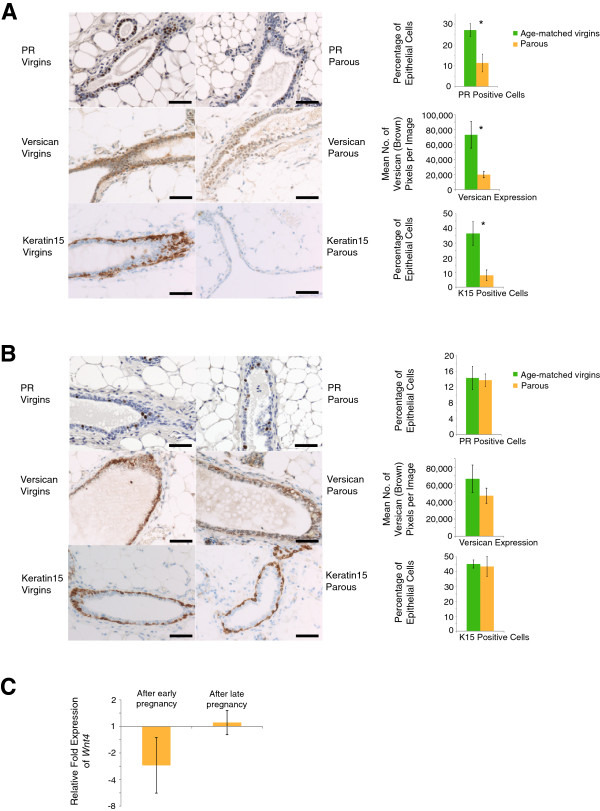Figure 1.

Effects of early and late parity on hormone (progesterone) sensitive cells and Wnt target gene (versican and keratin 15) expression in mice. (A) Early parity-induced decrease in expression of progesterone receptor (PR) and Wnt target genes versican and keratin 15 persists in old mice. Six-week-old mice (FVB/NHanHsd) were time-mated and allowed to lactate their pups for 21 days. Mammary glands were harvested after cessation of the estrus cycle when mice were 22 months old. Immunohistochemical staining of sections of pffin-embedded mammary glands for PR, versican and keratin 15 (K15) and their quantification were performed as described previously [6]. Scale bars = 50 μm. For PR, quantitative data represent the mean ± standard deviation (SD) of 2,500 counted cells from five virgin mice and five parous mice. For versican, quantitative data represent the mean ± standard error of the mean (SEM) of 70 randomly selected images from five virgin mice and five parous mice. For keratin 15, quantitative data represent the mean ± SD of 1,500 counted cells from three virgin mice and three parous mice. By two-tailed unpaired Student t test: for PR, P = 1.53 × 10−4; for versican, P = 0.004; for keratin 15, P = 0.0049. Primary antibodies included anti-progesterone receptor (Clone SP2, catalog number RM-9102; ThermoScientific, Lausanne, Switzerland), versican (catalog number ab1033; Millipore/Chemicon, Billerica, MA, USA), keratin 15 (EPR1614Y, catalog number ab52816; Abcam, Cambridge, UK), and secondary antibodies were biotinylated anti-rabbit IgG (catalog number BA-1000; Vector Labs, Peterborough, UK) and anti-rabbit horseradish peroxidase-conjugated polymer Immpress (catalog number MP-7401; Vector Labs). (B) Late pregnancy does not significantly decrease the proportion of PR-positive cells and the expression of Wnt targets versican and keratin 15. Twenty-four-week-old mice were time-mated and allowed to lactate their pups for 21 days. The postweaning period until gland harvest was identical to the early parity protocol (that is, 40 days) as described previously [6]. Immunohistochemical staining was performed as in (A). Scale bars = 50 μm. For PR, quantitative data represent the mean ± SD of 2,500 counted cells from five virgin mice and five parous mice. For versican, quantitative data represent the mean ± SEM of 70 randomly selected images from five virgin mice and five parous mice. For keratin 15, quantitative data represent the mean ± SD of 1,500 counted cells from three virgin mice and three parous mice. By two-tailed unpaired Student t test: for PR, P = 0.72; for versican, P = 0.28; for keratin 15, P = 0.71. (C) Early pregnancy leads to a persistent decrease in Wnt4 expression in snap-frozen mammary glands. In contrast, no change in Wnt4 expression was observed after late pregnancy. Quantitative polymerase chain reaction was performed on snap-frozen mammary glands from parous and age-matched virgin control mice, using Hprt as a reference gene. Data are presented as fold expression in mammary glands from parous mice relative to age-matched virgin control mice. Data represent the mean ± SD of tissues from seven to 10 mice per group.
